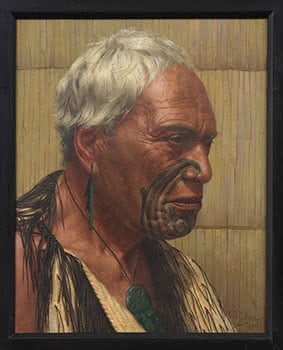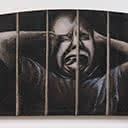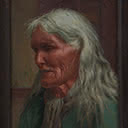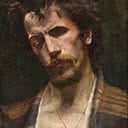A Chief of the Ngatimahuta Tribe Te Kamaka, Ngati Maniapoto, 1916 - 'The Whitening Snows of Venerable Eld. '
26 x 19 cm
est. $700,000 - 1,000,000
PROVENANCE
Private Collection, by descent
Acquired from Bethune's Auction, Wellington,
2 September 1964
EXHIBITED
Auckland Society of Arts, 37th Annual Exhibition
Auckland, 1918, cat no.75
Robert McDougall Art Gallery, Christchurch,
1969. Original Robert McDougall Art Gallery
label affixed verso
REFERENCE
Alister Taylor and Jan Glen, C F Goldie: His Life &
Painting, (Auckland: Alister Taylor Publishers,
1977), p.238
Charles Frederick Goldie's 1916 portrait of Te Kamaka is nothing short of an artistic tour de force. In executing this work, Goldie deployed technical finesse, allowing him to powerfully express the likeness and mana of his sitter. Goldie painted Te Kamaka, a rangatira of Ngati Maniapoto, on at least four occasions between 1916 and 1921. The series of portraits of Te Kamaka are catalogued in C F Goldie, His Life & Painting by Alister Taylor & Jan Glen (Martinborough 1977) as follows: Te Kamaka, 1916, The Diplomatist, Te Kamaka - a chieftain of the Ngati Maniapoto, Tribe, King Country, 1918, The Aristocrat Te Kamaka, Ngati Maniapoto tribe, Aged 90 Years. The present work is a sensitive and reverent rendering of Te Kamaka, comprising careful yet spirited, visible brushstrokes. It has been composed with such precision as to avoid obfuscating the finer detail of the sitter's visage, but is also expressive enough in its painted manner to enhance the effect of the work's ambient light interplay; illumination is derived from a strong singular light source coming from the left of the painting. Goldie's portraits of Maori are celebrated for their ability to realistically capture the mana and likeness of his sitters. Writing on the 1918 exhibition of the Auckland Society of Arts, the reviewer for the New Zealand Herald observed: Mr. Goldie's work consists of small portraits, finished with his characteristic perfection of detail, and splendidly typical of the Maori, in whom he finds such constant inspiration. (31 May 1918). Amongst the works on display in the exhibition was the painting depicted here of Te Kamaka titled 'The Whitening Snows of Venerable Eld': Kamaka An Chieftain of the Maniapoto Tribe (Aged 90 Years). The title of this work was taken from James Thompson's allegorical poem The Castle of Indolence (1748). Goldie regularly titled his paintings with phrases borrowed from British poetry.
Through his lifetime and legacy Charles Frederick Goldie greatly influenced our nation's artistic and cultural consciousness. Born in Auckland on 20 October 1870, one of eight children from the marriage of Maria Partington and David Goldie, he was named after his maternal grandfather, Charles Frederick Partington, builder of the landmark Auckland windmill.
In 1883 the young Goldie was enrolled at Auckland Grammar School. His youthful artistic talents shone and it was not long before he was winning prizes at the Auckland Society of Arts. On leaving school Louis John Steele became his mentor and tutor. Two of the young artist's still life paintings so impressed Sir George Grey that he convinced David Goldie to allow his 22 year old son to attend the Académie Julian in Paris. Goldie spent over four years at the Académie Julian tutored by leading lights of the Paris Salon such as William-Adolphe Bouguereau. In 1898, fully informed in the French academic style, the artist returned to New Zealand and began collaborating with his former tutor Louis John Steele. The two worked on a number of paintings including The Arrival of the Maoris in New Zealand, a large scale history painting after Gericault's Raft of the Medusa. Before long, however, the relationship deteriorated likely caused by tensions around the former student's growing success. Goldie went on to open his own studio and establish himself as a successful portraitist of Maori.
A visit to Rotorua in 1901 was the first of several field trips during which the artist was introduced to local Maori and persuaded them to sit for portraits. Goldie's works from this point forward strongly reflect the European tradition in which he was trained, and possess a stunning power and visual clarity. On the one hand his remarkable dedication to realism belies an ethnographic interest, at the same time he was also striving to capture the mana of his sitters who included chiefs, tohunga and kaumatua. Goldie formed long-standing relationships with several Maori he met and painted around this period, including Wiremu Patara Te Tuhi and Te Aho-o-te-rangi Wharepu (Ngati Mahuta), Ina te Papatahi (Nga Puhi), and Wharekauri Tahuna (Ngati Manawa).
Over the next two decades Goldie gained national and international acclaim and steady demand formed a strong market for his portraits. A number of which would later be exhibited at the Royal Academy of Arts in London and the Paris Salon throughout the 1930s. In 1920 the artist moved to Sydney, where despite original plans to continue on to Paris, he was married, at age fifty to thirty five year old Olive Cooper. Marriage in Sydney circumvented the Goldie family disapproval of the relationship between Auckland's famous artist and the milliner from Karangahape Road. After two years in Sydney, apparently disillusioned with his work at this time and suffering from health problems Charles and Olive returned to New Zealand. Goldie's return to Auckland in 1924 ultimately represented a moment of artistic reckoning. Goldie received encouragement to resume painting from Governor General Lord Bledisloe. Devoting himself once again to his work he began to apply a more liberal, impressionistic approach to the realisation of his portraits and repainted a number of his former subjects. Works from this later period are distinguished by their soft luminescence, offering a rhythmic departure and disconnection from the rigours of formalism to which he had so strictly adhered in the past.
Goldie died in Auckland in 1947, his exquisite, spirituallycharged, often unsettling and ever powerful portraits of Maori having made an unsurpassed contribution to the history of art in New Zealand.





